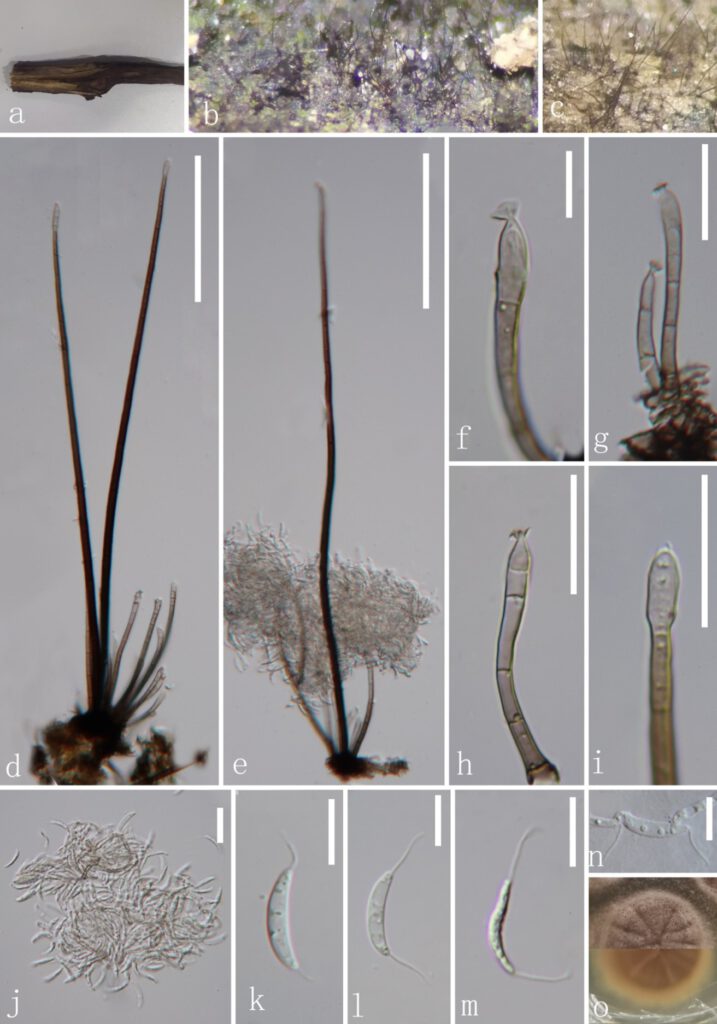Codinaea aseptata J.Y. Zhang, Y.Z. Lu & K. D. Hyde, in Zhang, Ma, Xiao, Boonmee, Kang & Lu, Journal of Fungi8(no. 643): 13 (2022)
Index Fungorum number: IF559697; MycoBank number: MB559697; Facesoffungi number: FoF 11038.
Etymology – Referring to the aseptate conidia.
Holotype – HKAS 123758
Saprobic on decaying wood submerged in freshwater habitats. Sexual morph: Undetermined. Asexual morph: hyphomycetous. Colonies on the natural substrate effuse, hairy, brown. Mycelium mostly immersed, composed of branched, septate, smooth, brown hyphae. Setae 339–417 μm long, 5–6 μm wide at the base (x̅ = 376.8 × 5.5 μm, n = 20), erect, dark brown at the base, subhyaline towards the apex, xx–xx-septate, unbranched, smooth, rarely fertilizable. Conidiophores 41.6–105.1 μm long, 2–3.74 μm wide at the base (x̅ = 66 × 3 μm, n = 15), macronematous, mononematous, in groups from the mycelial knots associated with the bases of setae, shorter than setae, erect, straight or slightly flexuous, short, cylindrical, unbranched, smooth-walled, septate, pale brown at the base, subhyaline at the apex. Conidiogenous cells 5.7–20 μm (x̅ = 12.2 μm, n = 20) long, monophialidic, integrated, determinate, terminal, cylindrical to cylindrical-lageniform, pale brown at the base becoming subhyaline to hyaline towards the apex, with flared collarette. Conidia 13.4–16.2 × 2.1–3 μm (x̅ = 14.2 × 2.6 μm, n = 20), acrogenous, solitary, aggregated in slimy droplets, aseptate, cylindrical or long fusiform, curved, with hair-like and 7–10 m long appendages at both ends, hyaline, smooth-walled, with small guttules.
Culture characteristics: Conidia germinating on PDA within 15 h and germ tubes produced from the base and the upper part. Colonies growing on PDA, reaching 19 mm diam. in 10 days at 25°C, circular, flat, entire to slightly filamentous, section to fan shape at the surface, taupe, becoming white towards the edge from above; yellowish-brown mycelium in the middle and pale yellow mycelium in the outer ring in reverse, and not producing pigmentation in culture.
Material examined – CHINA, Hainan Province, Wuzhishan City, Wuzhishan Tropical Rainforest Scenic Area, on decaying wood submerged in a freshwater stream, 15 August 2021, Zheng Luo, WZ48 (HKAS 123758, holotype; GZAAS 22-0072 isotype); ex-type living cultures, GZCC 22-0081.
GenBank accession numbers – LSU ON502890, ITS ON502897
Notes – Four morphotypes (C1–C4) of Codinaea were provided by Réblová et al. [16]. The morphological characteristics of our new isolate match well with the generic concept of Codinaea and fit well with the morphotype C1. Codinaea aseptata is most similar to Co. terminalis due to having setae in fascicles with conidiophore, phialidic and terminal conidiogenous cells and aseptate, falcate conidia with setulae at both ends [9]. However, our new isolate differs from Co. terminalis in its obviously longer and rarely fertilizable setae. BLAST results of ITS and LSU sequence data are Codinaea acacia OTU5 (96.09% similarity) and Co. paniculate MFLU 34876 (99.43 similarity), respectively. The phylogenetic tree (Figure 1) showed our new isolate of Cod. aseptata formed an individual lineage in the Codinaea clade but without statistical support shown in the phylogenetic tree (44% ML/-). This may be due to the consideration that many close phylogenetic relatives of our new collection have not yet been discovered. Hence, Codinaea aseptata was introduced as a new species based on its distinct morphology and phylogenetic evidence.

Figure 4. Codinaea aseptata (HKAS 123758, holotype). (a) Host material; (b,c) Colonies on woody substrate; (d,e) Setae and Conidiophores; (f–h) Conidiophores and conidiogenous cells; (i) Apex of seta;(j–m) Conidia; (n) Germinated conidium; (o) Culture on PDA from above and below. Scale bars: (d,e) 100 μm; (f,k–n) 10 μm; (g–j) 20 μm.
